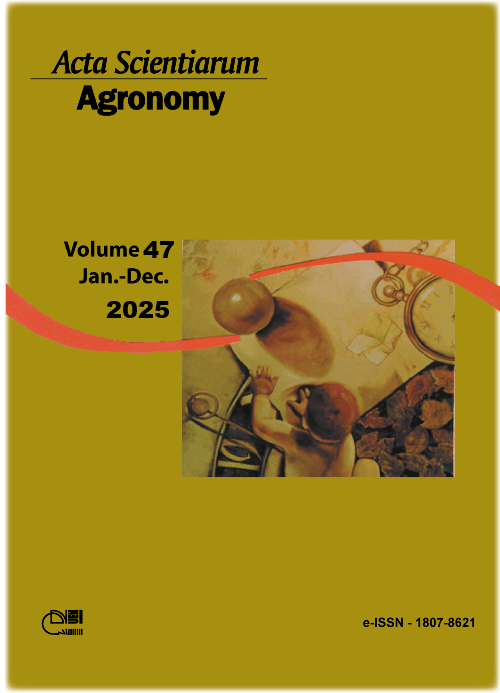AgroR: An R package and a Shiny interface for agricultural experiment analysis
Resumo
Statistical analysis is central to agricultural research, but the complexity of statistical methodologies and programming languages, such as R, often poses challenges for researchers. To address these difficulties, we present AgroR, a comprehensive R package and Shiny web application (https://uel.br/fisher.uel.br/AgroR_shiny) designed to streamline the analysis of agricultural experiments. AgroR supports a wide range of experimental designs, offering tools for analysis of variance, multiple comparison tests, and assumption validation, as well as functions for exploratory data analysis and graphical representation. The package is built for accessibility, allowing users with limited programming skills to perform advanced statistical analyses using an intuitive interface. The Shiny application enhances usability by providing a graphical interface that simplifies the running of statistical tests and visualization of results. AgroR includes functions for analyzing complex experimental designs, such as factorial and split-plot designs, and offers additional tools for graphical outputs and dataset management. Available through the CRAN repository and accessible via a web browser, AgroR has been widely adopted, with thousands of downloads and citations across the scientific literature. AgroR significantly lowers the barriers to statistical analysis in agricultural research by providing a user-friendly interface and robust statistical capabilities, thereby enabling more accurate and reliable conclusions.
Downloads
Referências
Arnhold, E. (2013). Pacote em ambiente R para análise de variância e análises complementares. Brazilian Journal of Veterinary Research and Animal Science, 50(6), 488-492. https://doi.org/10.11606/issn.1678-4456.v50i6p488-492
Arnhold, E. (2014). Pacote em ambiente R para automatizar estatísticas descritivas. Sigmae, 3(1), 36-42.
Bailar, J. (1986). Science, statistics, deception. Annals of Internal Medicine, 104(2), 259-260. https://doi.org/10.7326/0003-4819-104-2-259
Barbin, D. (2013). Planejamento e análise estatística de experimentos agronômicos. Editora Mecenas.
Box, G. E. P., & Cox, D. R. (1964). An analysis of transformations. Journal of the Royal Statistical Society: Series B (Methodological), 26(2), 211-243. https://doi.org/10.1111/j.2517-6161.1964.tb00553.x
Chang, W., Cheng, J., Allaire, J., Xie, Y., & McPherson, J., (2022). Shiny: Web application framework for R. https://cran.r-project.org/web/packages/shiny/index.html
Ferreira, P. V. (2018). Estatística experimental aplicada às Ciências Agrárias. UFV.
Fox, J., S., Weisberg, D., Adler, D., Bates, G., Baud-Bovy, S., Ellison, S., & Heiberger, R. (2012). Package 'car'. R Foundation for Statistical Computing.
Gross, J., & Ligges, U. (2015). Nortest: tests for normality (R package - version 1.0-4). https://CRAN.R-project.org/package=nortest
Hothorn, T., Bretz, F., Westfall, P., Heiberger, R. M., Schuetzenmeister, A., & Scheibe, S. (2016). Package 'multcomp'. Simultaneous inference in general parametric models. Project for Statistical Computing.
Knief, U., & Forstmeier, W. (2021). Violating the normality assumption may be the lesser of two evils. Behavior Research Methods, 53, 2576-2590. https://doi.org/10.3758/s13428-021-01587-5
Kormann, R., Rosa, E. N., Paixão, C. A., Ferreira, E. B., & Nogueira, D. A. (2019). GExpDes: Interface gráfica para o ExpDes. Sigmae, 8(2), 170-179.
Lenth, R. (2023). Emmeans: Estimated marginal means, aka least-squares means (R package - version 1.8.5). https://CRAN.R-project.org/package=emmeans
Lúcio, A. D., Schwertner, D. V., Haesbaert, F. M., Santos, D., Brunes, R. R., Ribeiro, A. L., & Lopes, S. J. (2012). Violação dos pressupostos do modelo matemático e transformação de dados. Horticultura Brasileira, 30(3), 415-423. https://doi.org/10.1590/S0102-05362012000300010
Martin, T. N., & Storck, L. (2008). Análise das pressuposições do modelo matemático em experimentos agrícolas no delineamento blocos ao acaso. In T. N. Martin, & M. F. Ziech (Eds.), Sistemas de produção agropecuária (pp. 177-196). UTFPR.
Melo, R. C., Trevisani, N., Santos, M., Guidolin, A. F., & Coimbra, J. L. M. (2020). Statistical model assumptions achieved by linear models: classics and generalized mixed. Revista Ciência Agronômica, 51(1), 1-9. https://doi.org/10.5935/1806-6690.20200015
Mendiburu, F., & Simon, R. (2015). Agricolae-Ten years of an open source statistical tool for experiments in breeding, agriculture and biology. PeerJ, 1, 1-18. https://doi.org/10.7287/peerj.preprints.1404v1
Nunes, C. A., Alvarenga, V. O., Souza Sant'ana, A., Santos, J. S., & Granato, D. (2015). The use of statistical software in food science and technology: Advantages, limitations and misuses. Food Research International, 75, 270-280. https://doi.org/10.1016/j.foodres.2015.06.011
R Core Team. (2022). R: A language and environment for statistical computing. R Foundation for Statistical Computing. http://www.R-project.org/
Ripley, B., Venables, B., Bates, D. M., Hornik, K., Gebhardt, A., Firth, D., & Ripley, M. B. (2013). Package 'MASS'. Cran R, 538, 113-120.
Shaner, G., & Finney, R. (1977). The effect of nitrogen fertilization on the expression of slow-mildewing resistance in Knox wheat. Phytopathology, 67(8), 1051-1056. https://doi.org/10.1094/Phyto-67-1051
Wickham, H., & Chang, W. (2017). ggplot2: Create elegant data visualizations using the grammar of graphics (R package - version 2.1). https://CRAN.R-project.org/package=ggplot2
Wickham, H., Chang, W., Danenberg, P., & Eugster, M. (2017). roxygen2: In-line documentation for R (R package - versão 6.1). https://CRAN.R-project.org/package=roxygen2
Xu, W., Li, W., & Song, D. (2013). Testing normality in mixed models using a transformation method. Statistical Papers, 54, 71-84. https://doi.org/10.1007/s00362-011-0411-4.
Zeileis, A., & Hothorn, T. (2002). Diagnostic checking in regression relationships. R News, 2(3), 7-10.
DECLARAÇÃO DE ORIGINALIDADE E DIREITOS AUTORAIS
Declaro que o presente artigo é original, não tendo sido submetido à publicação em qualquer outro periódico nacional ou internacional, quer seja em parte ou em sua totalidade.
Os direitos autorais pertencem exclusivamente aos autores. Os direitos de licenciamento utilizados pelo periódico é a licença Creative Commons Attribution 4.0 (CC BY 4.0): são permitidos o compartilhamento (cópia e distribuição do material em qualqer meio ou formato) e adaptação (remix, transformação e criação de material a partir do conteúdo assim licenciado para quaisquer fins, inclusive comerciais.
Recomenda-se a leitura desse link para maiores informações sobre o tema: fornecimento de créditos e referências de forma correta, entre outros detalhes cruciais para uso adequado do material licenciado.




















































